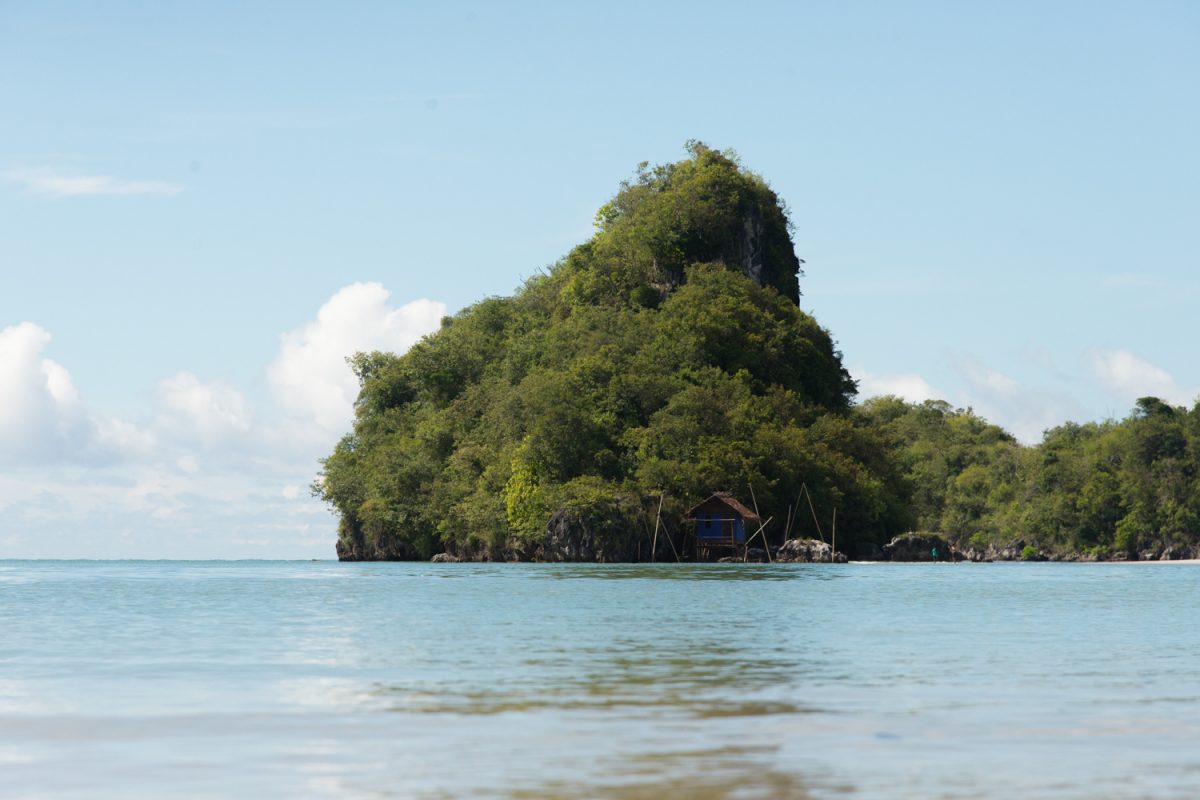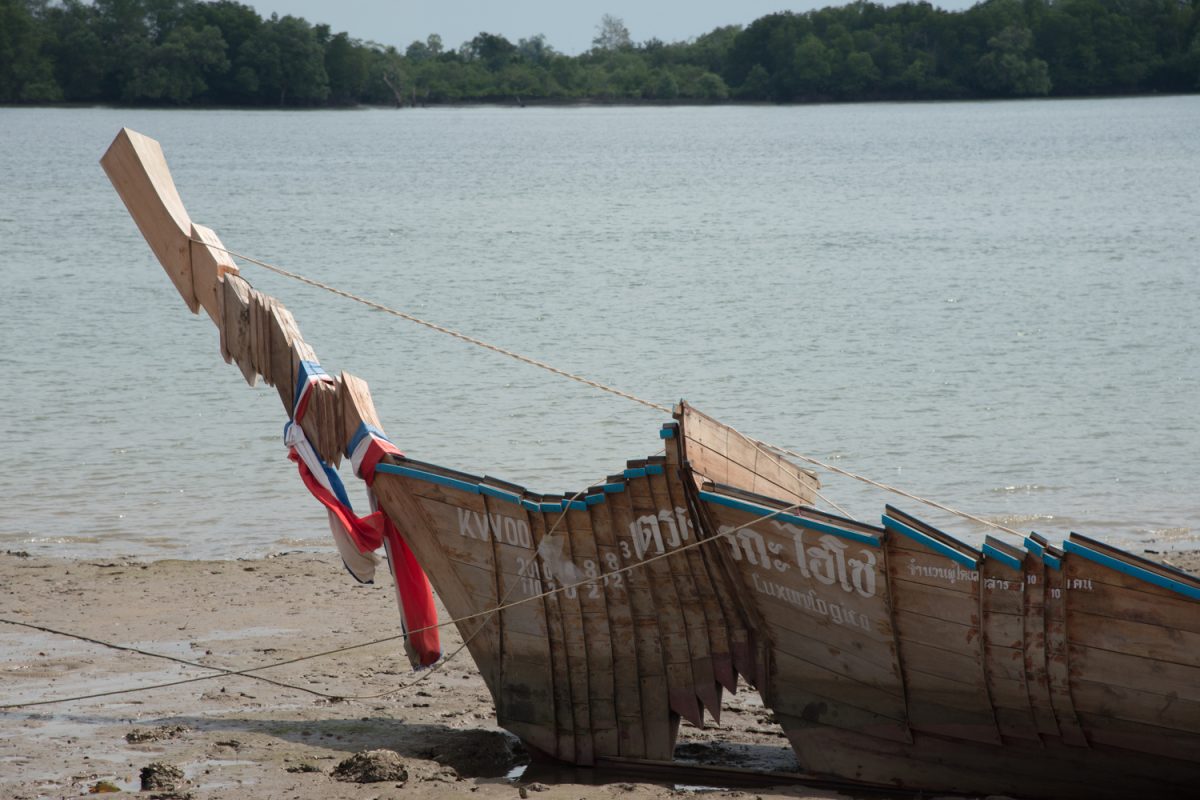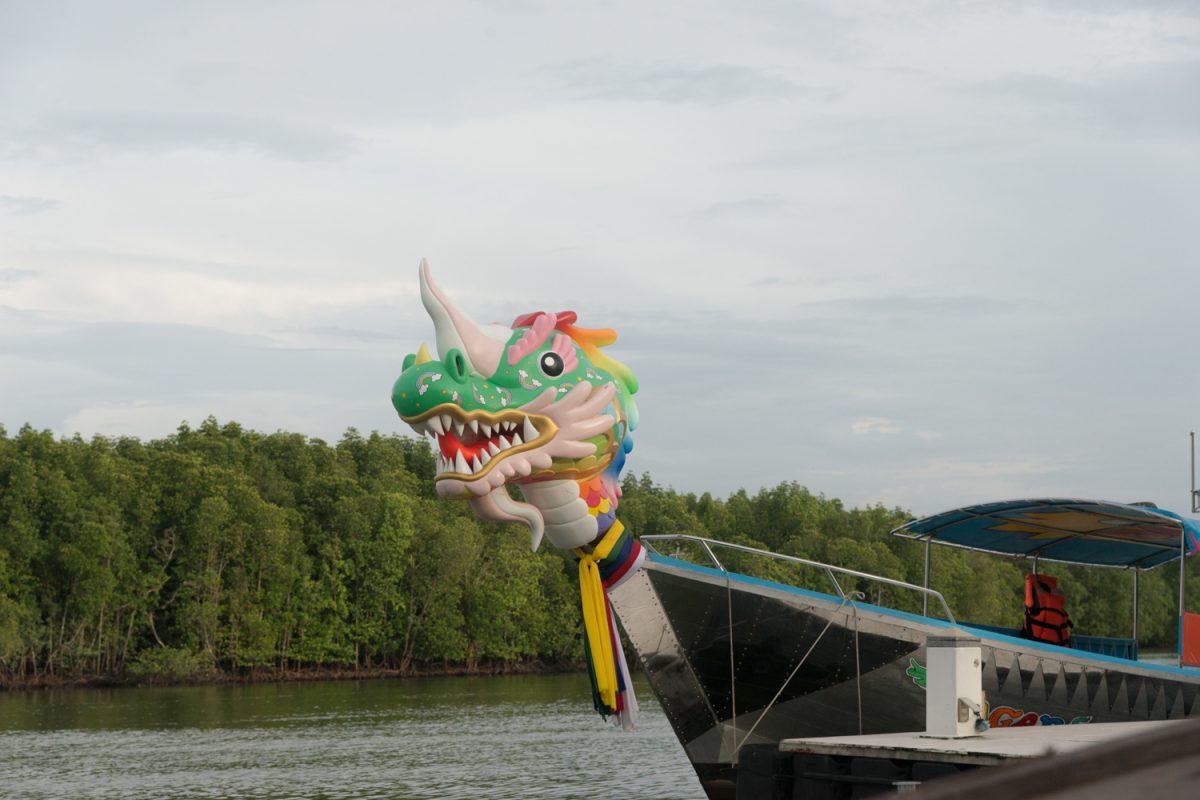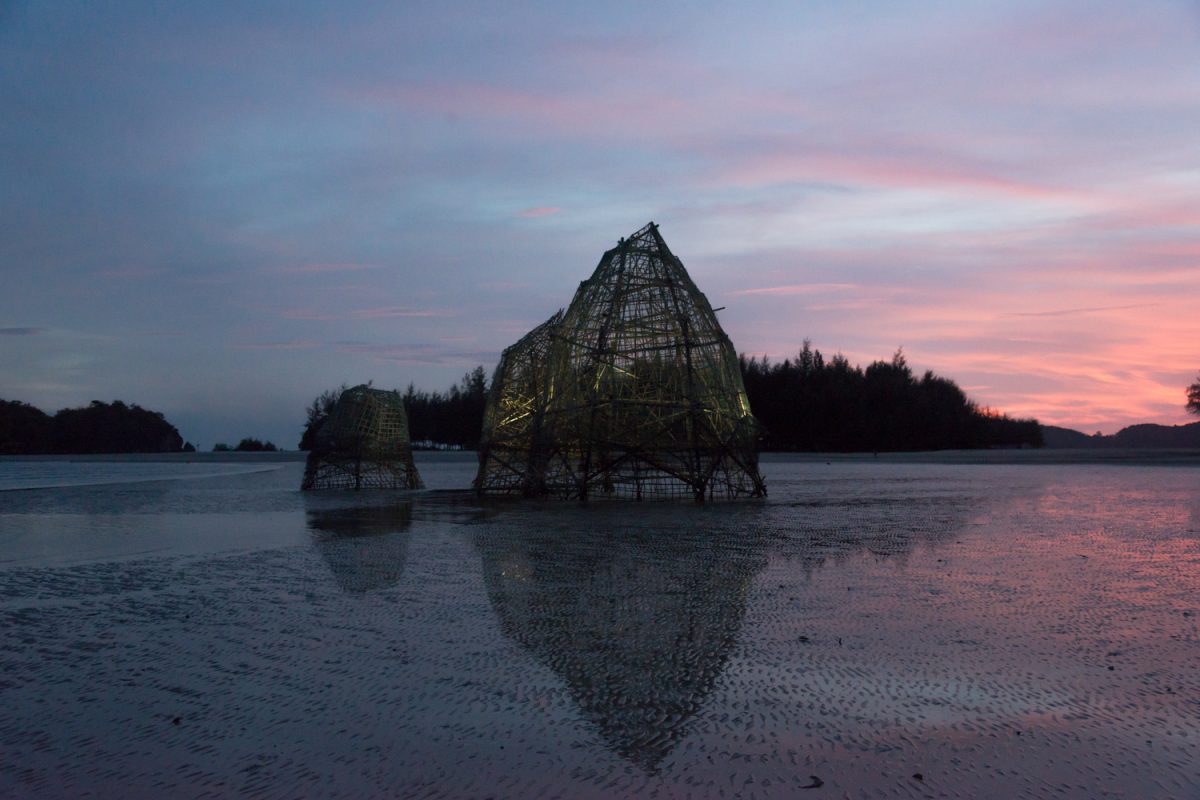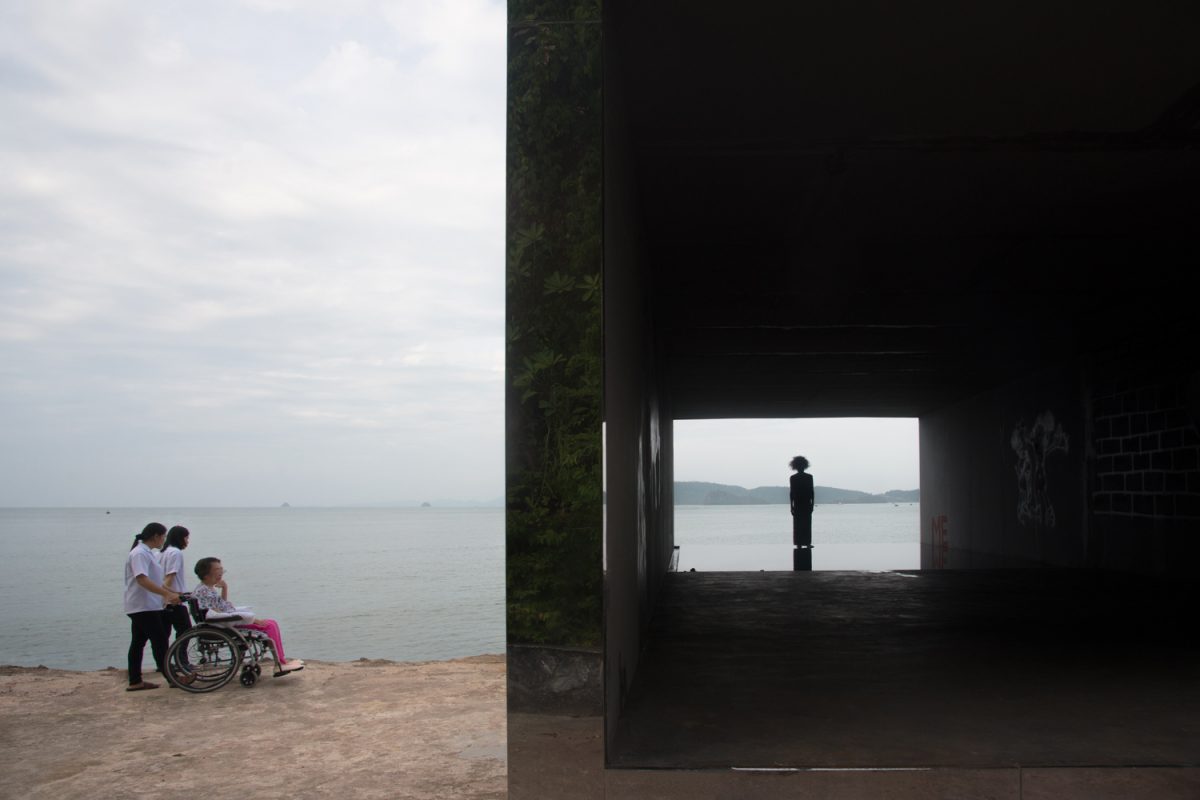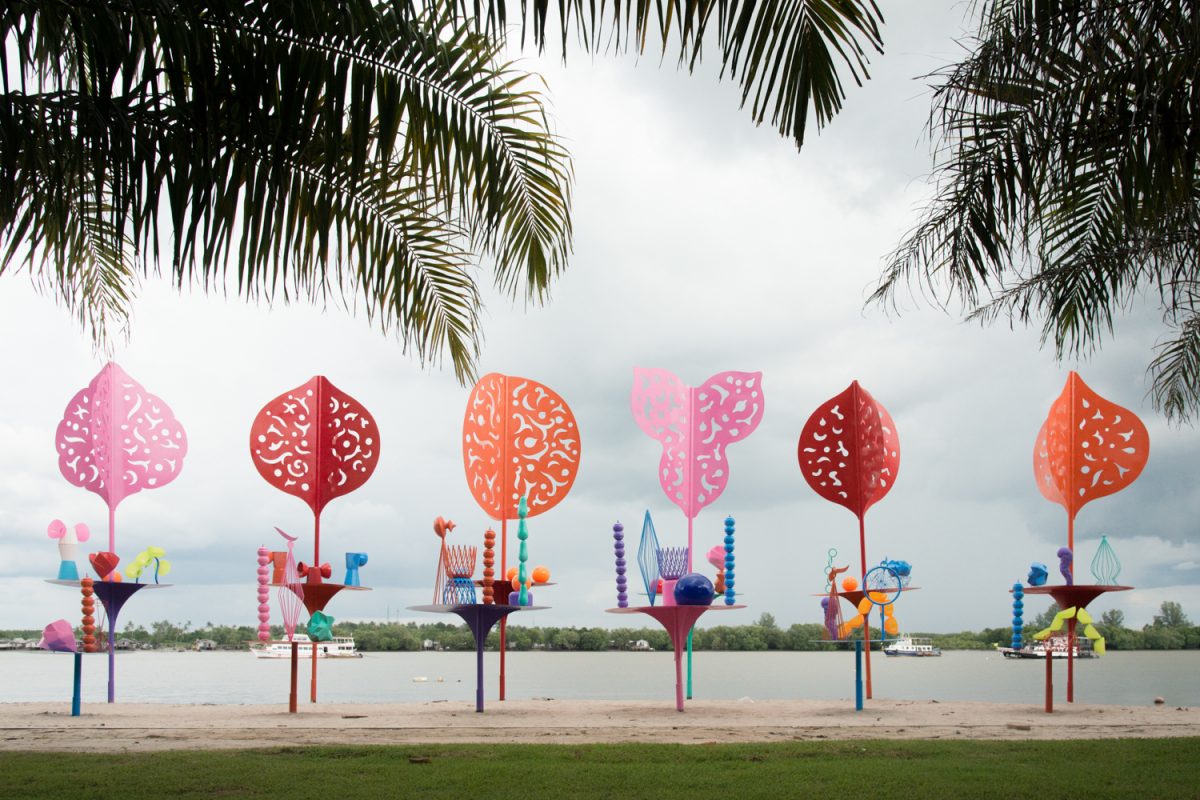INTRODUCING THE ART BIENNALE SUPPORTED BY THE TAXES OF THAI CITIZENS WHERE YOU CAN FIND CONTEMPORARY ART HIDING AMONG THE GREAT NATURE
TEXT & PHOTO: NAPAT CHARITBUTRA
(Scroll down for English)
Thailand Biennale, Krabi 2018 มีสำนักงานศิลปวัฒนธรรมร่วมสมัย กระทรวงวัฒนธรรมและจังหวัดกระบี่ เป็นเจ้าภาพจัดงาน โดยได้ Jiang Jiehong เป็นคิวเรเตอร์หลักของรายการ งานศิลปะกว่า 50 ชิ้น ถูกวางไปตามจุดต่างๆ ของจังหวัดกระบี่ เริ่มตั้งแต่งานประติมากรรมจากศิลปินท้องถิ่นที่กระจายตัวอยู่สองข้างถนนจากสนามบินนานาชาติจังหวัดกระบี่ถึงตัวเมืองสถานที่ท่องเที่ยวทางทะเลอย่าง อุทยานแห่งชาติหาดนพรัตน์ธารา-หมู่เกาะพีพี เทศบาลเมืองกระบี่ ไปจนถึงธารโบกขรณี และแหล่งท่องเที่ยวศึกษาธรรมชาติอย่างท่าปอมคลองสองน้ำ ซึ่งทำให้ Thailand Biennale กลายมาเป็นเบียนนาเล่แรกในไทยที่สถานที่จัดงานทั้งหมดเป็นพื้นที่กลางแจ้ง 100%
คำถามที่ตามมาคือ กระบี่พร้อมหรือไม่ที่จะจัดงานระดับเทศกาลศิลปะ? การเลือกกระบี่ประเดิมเป็นที่จัดเบียนนาเล่ครั้งแรกไม่ได้เกิดขึ้นลอยๆ ถ้ามองย้อนกลับไป เราจะเห็นความพยายามผลักดันให้กระบี่เป็นเมืองศิลปะมาระยะหนึ่งแล้ว เริ่มตั้งแต่การได้รับการสนับสนุนงบประมาณจากกลุ่ม 5 จังหวัดภาคใต้ฝั่งอันดามัน จัดตั้งศูนย์การเรียนรู้วัฒนธรรมอันดามันเป็นพื้นที่จัดนิทรรศการถาวรและหมุนเวียนเกี่ยวกับวัฒนธรรมของห้ากลุ่มจังหวัดภาคใต้ฝั่งอันดามัน หรือความพยายามแต่งแต้มบรรยากาศสร้างสรรค์ให้เกิดขึ้นด้วยการนำงานประติมากรรมไปประดับตามจุดต่างๆ ในตัวเมือง ทั้งหมดนี้มีวัตถุประสงค์เพื่อส่งเสริมอุตสาหกรรมท่องเที่ยวของจังหวัดไม่ต่างอะไรกับวัตถุประสงค์ของการจัดเบียนนาเล่ หรือในด้านโครงสร้างพื้นฐานของเมือง สนามบินนานาชาติของกระบี่กำลังพัฒนาอย่างต่อเนื่องส่วนในด้านการเดินทางในเมืองนั้น ถึงแม้กระบี่จะยังไม่มีระบบขนส่งสาธารณะที่ดี แต่ก็ต้องยอมรับว่าการเดินทางไปแต่ละจุดในเมืองค่อนข้างสะดวกสบายทีเดียวไม่ว่าจะทางทะเลและทางบก
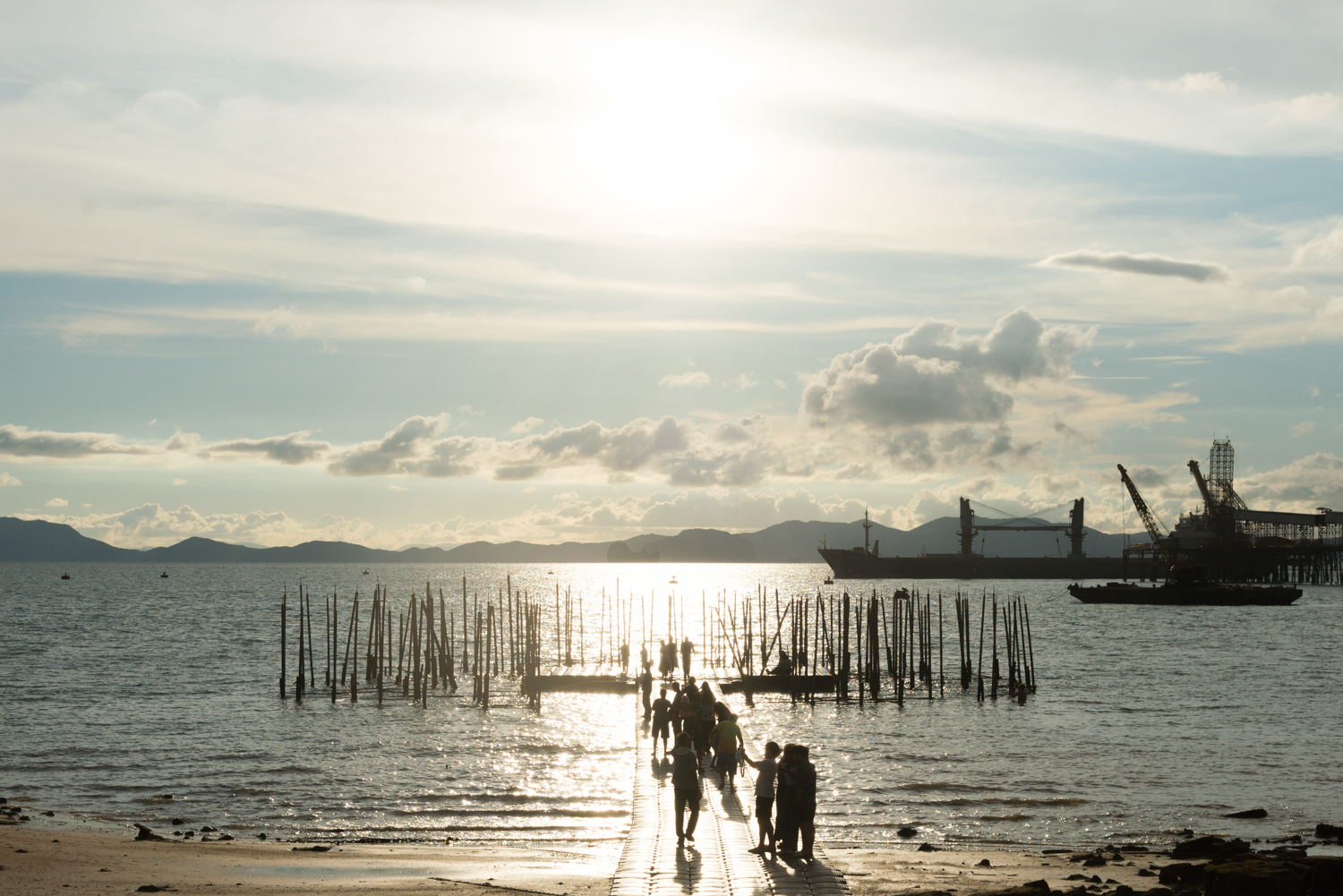
‘Rumors from the sea’ (2018) by Félix Blume at Ko Kwang’s floating pier.
ถึงแม้จะถูกปูทางมาเรื่อยๆ แต่การเกิดขึ้นของเบียนนาเล่ครั้งนี้ ก็ต่างไปจากทุกๆ สิ่งที่เคยเกิดขึ้นมา การบ้านที่ผู้จัดต้องทำคือการ educate คนในเมืองว่าอะไรคือศิลปะร่วมสมัย? การเตรียมความพร้อมในลักษณะนี้ไม่ได้ทำแบบทื่อๆ ด้วยการลิสต์เป็นข้อๆ ว่าศิลปะจะให้อะไรกับชุมชนบ้าง? แน่นอนว่าลำพังแค่การโน้มน้าวให้ชุมชนเชื่อว่าการนำศิลปินเข้ามาทำงานในพื้นที่จะดึงดูดเม็ดเงินเข้ามามากขึ้นนั้นคงไม่เพียงพอ ทำไมพวกเขายังต้องการศิลปะอีกล่ะ? เพราะแค่แหล่งท่องเที่ยวทางทะเลที่กระบี่มีก็สามารถดึงดูดนักท่องเที่ยวจากทั่วโลกได้อยู่แล้ว
ในวิดีโอประชาสัมพันธ์ Thailand Biennale ตัวหนึ่ง เป็นเรื่องราวของเด็กผู้หญิงตัวเล็กๆที่พบว่าอยู่มาวันหนึ่ง ภายในเมืองกระบี่ก็เต็มไปด้วยป้ายประชาสัมพันธ์งานศิลปะชื่ออ่านยากๆ (พ่อของเธออ่านว่า “อาเบเล่”) เธอเจอเข้ากับฝรั่งคนหนึ่งที่เรียกตัวเองว่า “อาทิตย์” ผู้ถือกล้องถ่ายรูป แอบติดตามเธอไปหลายๆ แห่ง และรู้สึกตกใจปนรำคาญว่าทำไมฝรั่งคนนั้นถึงตื่นตาตื่นใจไปกับวัฒนธรรมท้องถิ่นที่เธอเห็นชินตาอยู่ทุกวัน ไม่ว่าจะเป็นการผูกผ้าเรือหัวโทง การทำผ้าบาติก หรือแม้กระทั่งควายตัวหนึ่งในทุ่งนา นายอาทิตย์คนนั้นตามมาเจอเธอบนชายหาดขณะกำลังขีดๆ เขียนๆ สีลงบนผ้าใบ เธอจึงตัดสินใจถามฝรั่งคนนั้นว่ามาทำอะไรที่นี่ (โดยการใช้ google translate แปล) นายอาทิตย์ตอบกลับมาว่าเขากำลังหาแรงบันดาลใจ และเฉลยว่าที่เธอเรียกเขาว่าอาทิตย์ๆ นั้น จริงๆ แล้วเขาคือ artist ต่างหาก
ถึงแม้จะชัดเจนว่าวิดีโอนี้จะมีวัตถุประสงค์เพื่อประชาสัมพันธ์เทศกาลศิลปะในวงกว้าง แต่ก็ปฏิเสธไม่ได้ว่ามันกำลังสื่อสารกับคนในพื้นที่ เด็กผู้หญิงเป็นเหมือนตัวแทนของคนในพื้นที่ที่ไม่เคยได้ยินชื่อเทศกาลศิลปะแบบนี้มาก่อน ส่วนฉากตอนที่หนุ่มฝรั่งโชว์ภาพที่เขาถ่ายในกล้องนั้น ก็เป็นการเอามุมมองของคนนอกที่มีต่อพื้นที่กลับมาให้คนในดูว่า นอกเหนือจากธรรมชาติที่สวยงาม วิถีชีวิตที่พวกเขาเห็นกันชินตาทุกๆ วันนั้นก็มีคุณค่าไม่แพ้กัน
สิ่งที่ผู้จัดกำลังสื่อสารกับคนในพื้นที่ไม่ใช่คำตอบต่อคำถามว่า “อะไรคือศิลปะร่วมสมัย” แต่กำลังแนะนำให้รู้จัก “การท่องเที่ยวเชิงศิลปะวัฒนธรรม” สอดรับกับวัตถุประสงค์ของทางจังหวัดที่ต้องการให้งานศิลปะช่วยเตือนใจให้คนหันมารักษามรดกทางวัฒนธรรม อย่างไรก็ตาม การใช้เทศกาลศิลปะเป็นตัวดึงดูดนักท่องเที่ยวครั้งนี้ดูจะไม่เข้าเป้าที่พวกเขาหวังไว้เท่าไหร่ และที่ตลกร้ายคือมันไม่ได้เป็นผลมาจากคุณภาพของเบียนนาเล่ (ต้องยอมรับว่าการประชาสัมพันธ์งานที่ไม่เพียงพอก็เป็นสาเหตุหนึ่ง) แต่มันเป็นเพราะข่าวเรือนักท่องเที่ยวชาวจีนล่มเมื่อช่วงเดือนกรกฎาคมที่ผ่านมาต่างหาก
กลับมาที่ผลงานศิลปะใน Thailand Biennale ครั้งนี้กันบ้าง ข้อจำกัดเรื่องการขนส่งกลายมาเป็นสภาพบังคับที่ทำให้ศิลปินต้องทำงานร่วมกับช่างท้องถิ่นและคนในพื้นที่โดยปริยาย งานแทบทุกชิ้นในเทศกาลศิลปะรายการนี้เป็นฝีมือชาวกระบี่ทั้งสิ้น ตัวอย่างที่น่าสนใจคือ Coming Community (2018) โดย Valentina Karga เกิดขึ้นจากความร่วมมือระหว่างศิลปินและชุมชนในพื้นที่ที่ร่วมกันบันทึกทั้งเรื่องราวในชีวิตประจำวัน ประวัติศาสตร์ ความเชื่อลงไปในอิฐแต่ละก้อน ก่อนจะนำมาก่อเป็นเสารูปร่างหน้าตาประหลาดบนหาดทรายด้านทิศตะวันตกของเกาะกลาง นอกจากการกระตุ้นให้เกิดบทสนทนาระหว่างคนในพื้นที่ การปรากฏตัวของงานร่วมสมัยชิ้นนี้ยังทำให้พื้นที่ตรงนั้นกลับมามีชีวิตและได้รับการดูแลรักษาจากชาวบ้านอีกครั้งหนึ่ง
ธีม Edge of the Wonderland หรือชื่อไทยว่า “สุดขอบฟ้าแห่งดินแดนมหัศจรรย์” อาจฟังดูฝันๆ จนทำให้เราคิดไปว่างานศิลปะเบียนนาเล่ครั้งนี้จะให้ความรู้สึกประหนึ่งเดินอยู่ในดิสนีย์แลนด์ ตัวอย่างผลงานที่เล่นกับบริบทของกระบี่ได้ดีคงจะเป็น A.K. Dolven ที่ตีความคำว่า “เกาะ” ออกมาด้วยน้ำเสียงที่ฟังดูเศร้าและเดียวดาย Did you leave your island (2018) ผลงาน sound installation ภายในบ้านไม้ริมทะเล (สร้างโดยสถาปนิกท้องถิ่น บัญชา มะ และช่างก่อสร้าง บังนุ) เป็นเสียงบทสนทนาตอบโต้กันในเรื่องของการปรับตัวเพื่อใช้ชีวิตในต่างแดน เรื่องราวจากคนประมาณ 3 คนนั้นกระจัดกระจาย และไม่เรียงเป็นเส้นตรง แต่เมื่อคำพูดว่า “ฉันมีความสุขในการทำงาน” “The people are very close. They share their dinner” “When I come to this island. I come for holiday” “ฉันไม่รู้ว่าเพื่อนบ้านของฉันชื่ออะไร?” “where’s your family” และ “คุณได้ออกจากเกาะไหม?” ค่อยๆ ร้อยต่อกันอย่างกระท่อนกระแท่น การเดินทางไปที่ไหนสักแห่งและติดอยู่ที่นั่นเป็นเวลานานก็ไม่ใช่เรื่องที่มีความสุขอีกต่อไป Did you leave your island ตั้งอยู่บนปลายหาดนพรัตน์ธารา และบ้านสีม่วงแห่งนี้จะตัดขาดจากโลกภายนอก กลายเป็นเกาะอย่างสมบูรณ์เมื่อน้ำทะเลขึ้น
เป็นผลลัพธ์ที่น่าแปลกใจเมื่องานศิลปะแบบ sound art ดูจะทำงานได้ดีกับพื้นที่กลางแจ้งนอกจาก Did you leave your island ที่พูดถึงข้างต้น Visions (2018) ผลงาน sound installation โดย Ignas Krunglevičius ทั้งที่ติดตั้งบนเกาะปอดะ และอุทยานแห่งชาติธารโบกขรณีนั้นเป็นอีกผลงานที่ดึงเอาสภาพแวดล้อมมาเป็นส่วนหนึ่งของผลงานได้อย่างดีในชนิดที่ว่าไม่จำเป็นต้องฟังออกว่าผลงานพูดถึงอะไรก็พอจะมีความรู้สึกอะไรบางอย่างกับเสียงและภาพตรงนั้นได้ไม่ยาก (ลองนึกภาพขณะกำลังเดินอยู่บนทางเดินเปลี่ยวๆ กลางป่าเขาแล้วมีเสียงพระสวดออกมาจากลำโพงเล็กๆ ดู)

‘Letter’ (2018) by Rikuo Ueda at Than Bok Khorani National Park.
นอกจากงานอินสตอลเลชั่น Rubber Life (2018) โดย ศราวุธ ดวงจำปา ที่ถูกวางห่างออกไปจากจุดแสดงงานหลัก และข้อจำกัดบางประการที่ทำให้งานบางชิ้นไม่สามารถสร้างขึ้นมาได้จริง (โดยเฉพาะบนเกาะปอดะ) และข่าวการแบนงานของศิลปินบางคน การ grouping งานศิลปะในแต่ละจุดนั้นค่อนข้างทำได้ดี โดยเฉพาะการรวมกลุ่มงานศิลปะขึ้นมาเป็นหย่อมๆในแต่ละจุดให้นักท่องเที่ยวเดินทางไปแล้วไม่รู้สึกว่าเสียเที่ยว ที่น่าสนใจคือการติดตั้งผลงานในธารโบกขรณี ในมุมมองหนึ่งมันอาจดูเหมือนยาก ทั้งการลำเลียงผลงานชิ้นใหญ่ๆ เข้าไปตามทางเดินแคบๆ หรือการดูแลรักษางานศิลปะในสภาพอากาศที่แปรปรวนชนิดที่สลับจากฝนตกมาเป็นแดดเปรี้ยงได้ในไม่ถึง 10 นาที อย่างไรก็ตาม ข้อจำกัดที่ว่านี้ก็กลับกลายมาเป็นจุดแข็งในการสร้างเส้นเรื่องของนิทรรศการ ขอบเขตของอุทยานแห่งชาติกลายเป็นการล้อมกรอบพื้นที่ และเส้นทางเดินที่ถูกวางไว้เป็นโครงข่ายของธารโบกขรณีกลายเป็นการจัดลำดับการเข้าถึงผลงานแต่ละชิ้นไปโดยปริยาย
ถ้ามองว่ากระทรวงวัฒนธรรมแบ่งงบประมาณจากงบสนับสนุนสร้างภาพยนตร์รณรงค์ให้คนรักชาติ (หลายสิบเรื่อง) มาจัดงานเทศกาลศิลปะที่มีเนื้อหาปลายเปิดกว้างต่อการตีความมากกว่า การจัดงาน Thailand Biennale, Krabi 2018 ขึ้นที่จังหวัดกระบี่คงเป็นเรื่องที่น่าสนับสนุนจริงๆ อีกสองปีถัดไป Thailand Biennale จะย้ายไปจัดในจังหวัดอื่นๆ ได้ยินมาว่าอาจจะเป็นนครราชสีมา ต้องรอดูว่าการย้ายไปจัดงานในเมืองที่มีภาพลักษณ์ของเมืองท่องเที่ยวลดลงมา ทางผู้จัดจะหยิบประเด็นไหนมาตั้งเป็นธีม และเราหวังเป็นอย่างยิ่งว่า Thailand Biennale จะถูกจัดขึ้นตลอดไป

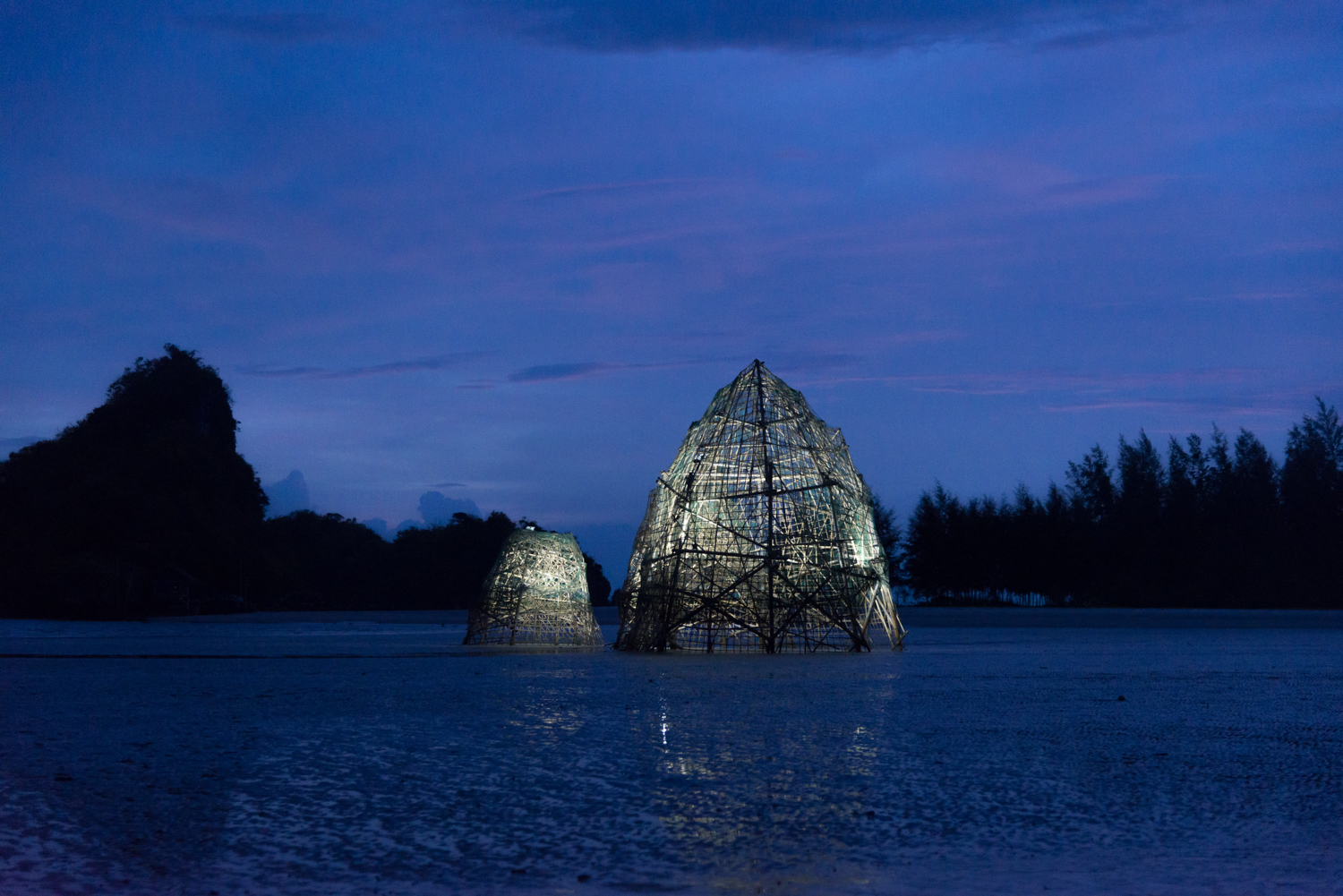
‘Ghost Island’ (2018) by Map Office, Hong Kong collective artist at Noppharat Thara Beach.
Thailand Biennale, Krabi 2018 co-hosted by the Office of Contemporary Art and Culture, Ministry of Culture and Krabi province with Jiang Jiehong as the chief curator, brings over 50 art pieces to various venues of the seafront town. The works range from sculptures by local artists scattered on both sides of the road from Krabi International Airport to the city center, installations at Noppharat Thara Beach – Phi Phi Islands National Park, to areas in Krabi Town, Than Bok Khorani National Park and other ecotourism destinations like Tha Pom Khlong Song Nam. This makes Thailand Biennale the first biennale in Thailand with 100% outdoor exhibition venues.
The question that follows is whether Krabi is ready to host an international art festival of such scale. Choosing Krabi as the debut venue isn’t something that came out of nowhere. Looking back, we’ve seen an attempt to advocate Krabi to become an art city for quite some time, whether it’s the financial support coming from five Andaman provinces for the establishment of Andaman Cultural Center or the endeavor to bring a creative atmosphere to the area with sculptures being placed in different spots in the city center. Everything is intended to promote the province’s tourism industry, which is something along the same lines as the objective of this biennale. In terms of the city’s infrastructure, there has been continual development invested in the improvement of Krabi International Airport and while the public transportation system isn’t exactly the most ideal, the commute to see the artworks (both inland and at sea) is surprisingly convenient.
While the way has been paved, the genesis of this biennale is quite different from its precedents. The homework that the organizer had to work out was how to educate people in the city about what exactly Contemporary art is. Such preparation is not just simply checking things off the list of how and what art can do to a community, and certainly persuading the local community to believe that bringing artists into the area can potentially generate more income for the locals wouldn’t be enough. Why would Krabi need art when its magical nature alone can attract travelers from around the world anyway?
One of Thailand Biennale’s promotional videos tells the story of a little girl who finds out that one day the city of Krabi is full of all these signs promoting an art festival whose name is difficult to pronounce (her father reads it out as a-be-le). She meets a foreigner who calls himself ‘Atit’ (Thai word for the sun) who takes his camera everywhere he goes as he follows her around to different places. Bewildered and a bit annoyed by how excited he seems to be by these local cultures she sees every day, from tying the head of a local fisherman boat with a piece of fabric for good luck to Batik textile making or even a buffalo in a rice paddy field, everything seems mesmerizing to him. The man found her again at a beach and while he was doodling with colors on a frame of canvas, she decides to ask him about his purpose coming here (using Google Translate, of course), and Mr. Atit replied that he was looking for inspiration before finally revealing that the name Atit she constantly calls him is actually ‘artist.’
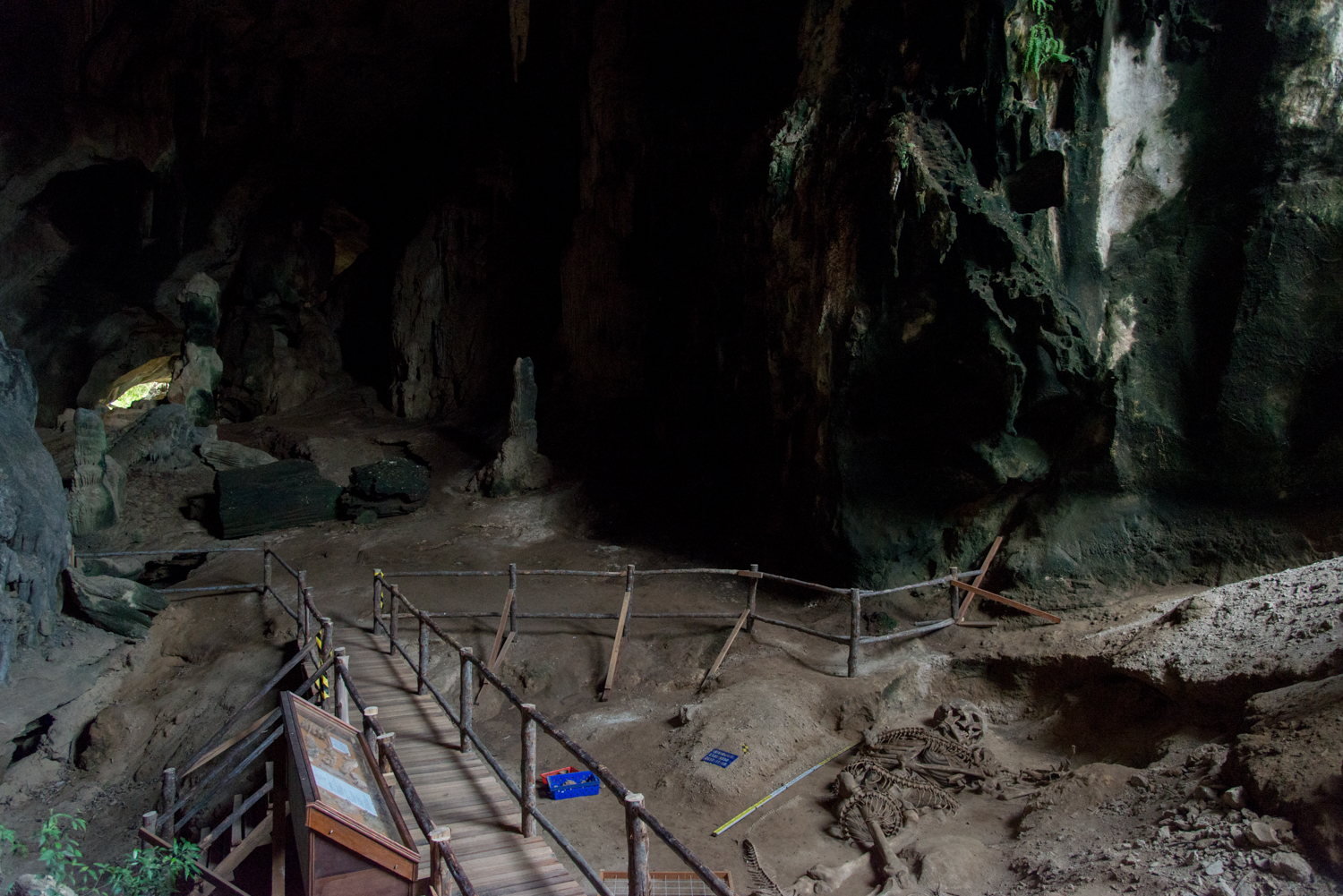
‘Giant Ruins’ (2018) by Tu Wei-Cheng at Khanab Nam Cave.
Although it’s pretty clear that the video aims to promote the festival to reach a wider audience group, it is undeniably obvious that it is communicating with the locals with the girl representing the Krabi residents who may have never heard about an art festival of such name. The scene where the foreign man shows her the images in his camera is pretty much a look into the outsider’s perspective and how the local way of life that seems mundane for the locals is just as valuable as the beautiful nature the province is known for.
What the organizer is trying to say through this video isn’t the answer to the ‘What is Contemporary art?’ question but more of an introduction of ‘art and cultural tourism,’ which corresponds with the province’s objective that aims for the art festival to serve as a reminder for the locals to be more appreciative of their culture. Nevertheless, the use of art festival as a tool to attract tourists doesn’t go quite as planned and the irony here is that it isn’t exactly the result of the quality of the biennale itself (although insufficient promotion can be one of the reasons), but something that has more to do with the boat accident in Phuket, which took place earlier in July of 2018.
Back to the artworks featured in the first Thailand Biennale. The limitation of transportation has become a condition that forces the artists to work with local builders and people, causing the production of almost every work of art in this festival to be done by Krabi locals. One interesting example is ‘Coming Community’ (2018) by Valentina Karga. Created from a collaboration between the artist and the local community who share a space where they together document stories happening in their everyday lives, including history and beliefs, on a number of bricks. The bricks are later constructed into an unusual looking pillar standing on the eastern end of the beach on Klang Island. In addition to its role as a conversation stimulator among community members, the emergence of this Contemporary art piece has brought the area back to life with the locals taking better care of the beach than they had been previously.
The theme ‘Edge of the Wonderland’ may sound a bit dreamy and could easily get people expecting this art biennale to be like a walk through Disneyland. One of the artists who plays with the context of Krabi quite well is A.K. Dolven. He interprets the word ‘island’ in a rather sad and isolating tone with ‘Did you leave your Island’ (2018), a sound installation piece inside a seaside wooden house (built by local architect Bancha Ma and builder, Bang Nu). Viewers hear the sounds of a reciprocating conversation about adjusting to life in a foreign land. Stories from the three people are scattered and non-linear with spoken words like “I’m happy with my work,” “The people are very close. They share their dinner,” “When I come to this island. I come for holiday”, “I don’t know what my neighbor’s name is,” “Where’s your family,” and “Did you leave your island? I come for Holiday” are incoherently woven, creating a feeling that traveling to and being stuck somewhere for an extended period of time is not always a happy experience. ‘Did you leave your island’ can be found at the end of Noppharat Thara Beach. This violet house is completely disconnected from the outside world and transformed into an island once the water level rises.
It’s a surprising consequence to see sound art pieces work this well with outdoor spaces. In addition to the earlier mentioned ‘Did you leave your island,’ ‘Visions’ (2018),a sound installation by Ignas Krunglevičius installed on Poda Island and Than Bok Khorani National Park is another work that impressively engages its surrounding nature to the point where we don’t even have to hear the exact words that are being said, yet we are able to easily sense something from the sounds and images we’re experiencing (imagine walking on a long isolated path in the middle of the jungle with the sound of monks chanting coming from a small speaker).
Apart from ‘Rubber Life’, (2018) by Saravudth Duangjumpa, which is installed quite a distance from the main exhibition venue, and certain limitations that caused some of the works to be unbuildable (particularly on Poda Island), and the news about the banning of some of the works, the grouping of works in each venue is executed quite impressively. The way the works are put in different clusters also makes each trip more satisfying for festival goers. The interesting thing is the installation of works inside Than Bok Khorani National Park, which in a way, can be a challenge, whether for the transportation of sizable art pieces through a narrow path, or the maintenance of the works under the extremely unpredictable island climate where stormy rain switches to unbelievably sunny skies within the span of 10 minutes. Nevertheless, such limitations have become strong points in the way the exhibition’s narrative has developed. The physical boundary of a national park becomes a perimeter while the curated routes of Than Bok Khorani National Park serve as circulation and a hierarchy in which each of the works is experienced.
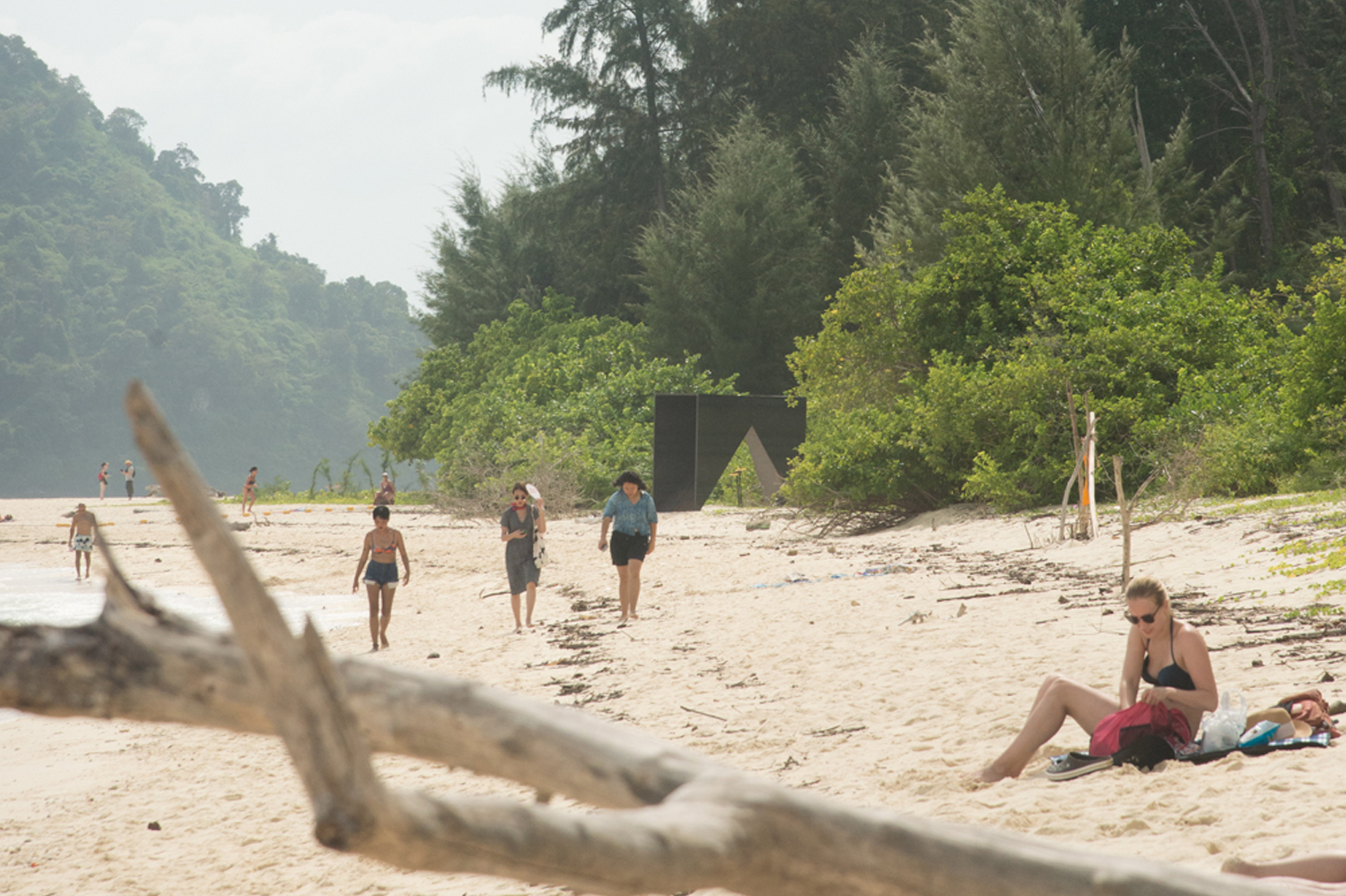
‘Vision’ (2018) by Ignas Krunglevičius sound installation art at Poda Island
To think that if the Ministry of Culture could spare something from a substantial sum of budget spent on the making of tens of films to promote a nationalistic belief regarding an art festival of such open-ended and interpretative content, Thailand Biennale, Krabi 2018 is worth all the support. No matter what the next destination will be for Thailand Biennale (we heard word that Nakhon Ratchasima may be chosen as the next venue), or what theme it will be held under, we wish for nothing but a long and lasting future for Thailand Biennale.


